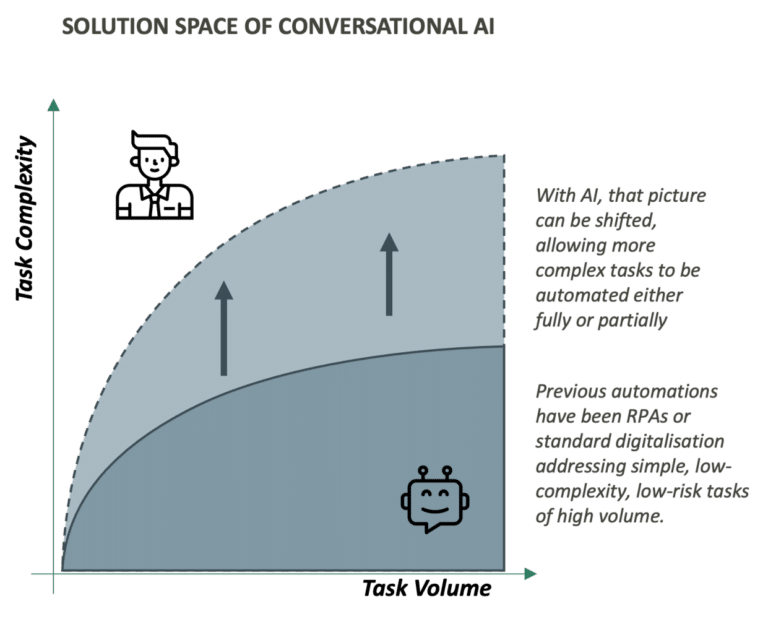Are you a forward-thinking Chief Customer Officer (CCO) or Chief Operating Officer (COO) looking to revolutionise your organisation’s customer service with AI? You are not alone. But before you rush in to join the crowd, let us start by demystifying the basics: what exactly is conversational AI, and why all the hype? And more importantly, what are the pitfalls you should be aware of?
Decoding conversational AI
Artificial Intelligence (AI) covers a spectrum of technologies, from reinforcement learning to neural networks and computer vision. In this article, we will zero in on the facet of AI that deals with understanding language—whether you label it Natural Language Processing (NLP), Large Language Models (LLM), or even ChatGPT.
These models have the capability to process, interpret, and understand language, generating contextually appropriate responses. In other words, they can direct a customer enquiry to the right colleague in seconds, find important topics in unstructured customer feedback, and suggest the right reply to even complex customer conversations or enquiries.
Capabilities of conversational AI in customer service
To understand what conversational AI could mean for your customer service department, just think of conversational AI models as digital counterparts to your human colleagues. Unlike previous robotic process automations, these AI colleagues excel at handling complex and time-consuming tasks that traditionally only human colleagues could manage:
- Solving tasks and understanding cases with the aid of ‘golden’ examples and business rules
- Retaining vast amounts of information, identifying patterns, and articulating answers more efficiently than manual research.
- Interacting with customers or employees in a simple, customer-friendly manner, maintaining precision and consistency in line with company policies.

Conversational AI models can be seen as digital counterparts to human colleagues with the ability to solve more complex tasks than what previous automation technologies have been able to.
Use case: conversational AI in practice
As a real-life example of how conversational AI can make a positive difference, we worked with a financial institution that wanted to improve operational efficiency in their call centre and offer their employees more motivating tasks. Legal obligations required meticulous documentation of customer interactions involving a large number of case templates.
We helped the client design a solution that listens to the conversation between customer and employee, transcribe the conversation and from the conversation recommends what to put into a summary of the conversation, easing the documentation. The purpose is for the customer service agents to spend more time connecting with customers and doing more interesting work requiring their specific expertise instead of drowning in routine documentation tasks.
There are many examples of the huge potential in implementing conversational AI in customer service, but it is not a cure-all. Be cautious when real human contact is vital, as when dealing with vulnerable customers. Also, steer clear when working with sensitive information such as medical records. Lastly, remember that some external customer communication often needs a human touch and that important customer messages should perhaps not be created by an AI model. This does not mean though that you cannot use conversational AI to help you create a draft or check that your message complies with company policies and tone of voice.
Steps to launch conversational AI in customer service
If you are still intrigued by the potential of conversational AI in your customer service department, here are your first important steps to get started:
- Identify prime use cases in your organisation where a digital colleague can make a significant impact. Seek areas where human involvement is non-essential, freeing up time for employees to focus on more critical and sensitive tasks
- Gauge the level of understanding and demand for AI within different parts of your organisation. Implementing AI solutions will require a lot of effort, both in terms of technology adaptation and in ways of working. A team or department where your employees already know quite a bit about AI and are eager to try it out is an ideal place to start
- Pinpoint tasks where speed, precision and consistency are crucial, and where entrusting responsibility to a digital colleague makes sense. These could typically be tasks that require routine processing of large volumes of information
Ensuring longevity
No matter how or when you start your conversational AI project, remember that once implemented, the AI model will require training and continuous modifications to remain effective. Just like a new colleague would need onboarding, training, continuous feedback, and upskilling to remain motivated. Otherwise, you risk ending up with a failed project within months of implementation. The AI model’s efficiency can deteriorate over time just as the motivation of a colleague will without feedback and support.
Continue the conversation
Do you want to learn more about the pros and cons of conversational AI or discover what a successful implementation project looks like? Reach out to Emilie Lundbye Dalsgaard (Senior Manager) for a chat.

What stage is your organisation in on its data-driven journey?
Discover your data maturity stage. Take our Data Maturity Assessment to find out and gain valuable insights into your organisation’s data practices.







